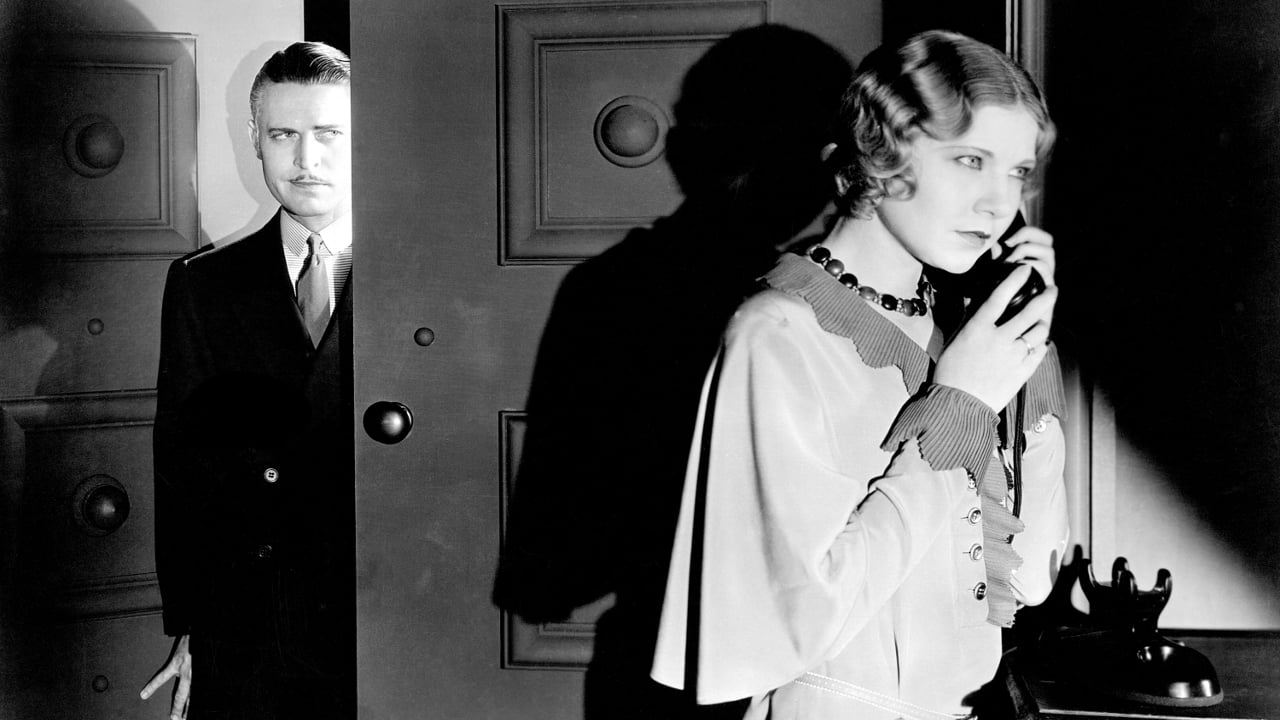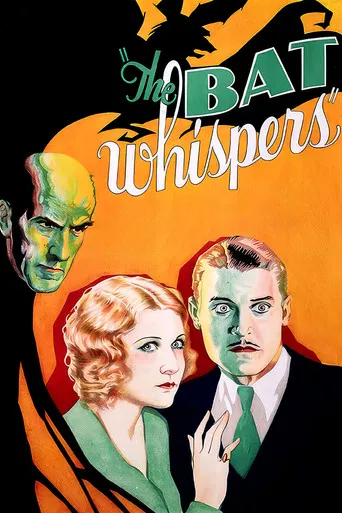

"The Bat Whispers" boasts striking, spacious sets and some remarkably (for 1930) fluid camera-work, but it still can't completely shake off its staginess, and it includes not one, not two, but three unfunny comic relief supporting characters (the maid's squealing is absolutely insufferable). As for who The Bat is, it is possible after a point to put 2 and 2 together and figure it out before he is unmasked. But the final 2 minutes are most unusual - for this ending, and the visuals, the film is worth a look. **1/2 out of 4.
... View MoreI've watched the 1926, 1930 and 1930 wide screen versions many times over the years. However, the other day I finally watched the widescreen on my 5x6 foot screen which I usually save for 3D and football. The details really jumped out. There are so many wonderful camera tricks, many of which I cannot explain. As a professional modeler I can say that the miniatures were far ahead of their time, as was the skill in photographing them. They probably were only exceeded beginning with the Star Wars attack on the death star.The fluidity of the camera was amazing for its time. The old lady and the maid walk down a long corridor, talking all the time as the camera moves ahead of them. They walk into a room and sit at a table which was right in the path of the camera. Later in the film a character vaults over a 3 foot wall and runs down a path with the camera following him, apparently right through the wall. The shadows of the Bat as he hulks on the floor are inhuman. On several startling occasions the characters jump right into the camera. These and more have been mastered for years but this film discovered them. If you are familiar with the climax of The Alibi, you remember the special effect that seemed almost real, not surpassed until CGI. The Bat Whispers is filled with such effects.Yes, the film is static, despite all the goings on. And the acting, although unacceptable by 1932 standards was about average for 1930. However, I would gladly have strangled Maude Eburn who ruined every scene she was in. The Bat Whispers is really a guilty pleasure for modelers, cinematographers and horror fans.
... View MoreBat Whispers, The (1930) 35mm version *** (out of 4) 65mm version ** (out of 4)The master criminal known as The Bat steals a necklace even though he warned police that he was going to do it. They believe he's taken shelter inside an old house, which is full of shocks and surprised for the Detective (Chester Morris) on the case. This film has a pretty strange history behind it since Roland was remaking his earlier film from 1926 and was shooting two different versions. The 35mm version is the one being reviewed it and for the most part I was shocked at how well made it was. What really shocked me is that a lot of these early sound films are quite horrid and hard to understand but that's not the case here as everyone from the director to the cast seem perfectly normal working with the sound. The actors really take off and know how to work their dialogue, which again is something I wasn't use to seeing in such a early sound film. The visual look of this film mixed in with the sound makes the film appear to be something made later in the decade and not at the start. The cast all turn in impressive performances starting with Morris who has become a favorite of mine over the past couple years. It took me a little while to warm up to his type of delivery but once I did I really enjoyed watching him and his style of comedy. Una Merkel is also very good as is Chance Ward and Richard Tucker. The film offers up a lot of comedy and for the most part it works including a scene where the two older women are being questioned and are asked how old they are. One tells and lie and this is one of the highlights of the film. Even before we get to the two versions of the film it's also important to note that the film offers up one of the first "dolly" shots with a special camera that was created just for this film, which allowed it to move 18-feet in the matter of seconds. There's also a sweeping camera shot that is way ahead of its time even though the miniature used is easy to spot. Some might find the story or settings full of clichés must one must remember that this is the film that influenced everything that would follow, which is saying quite a bit for director West as his 1926 film influenced all the future silent old dark house films. After the film we also get a quick "warning" from The Bat telling people not to spoil the movie for those who haven't seen it.The 65mm version features the exact same story and cast but of course it's shown in an early widescreen format and features all new shots by a different cinematographer. It's really amazing at how different these two versions are and I'd say the 65mm is more of a curiosity than anything else. I think the best film is the 35mm version for various reasons. For one, the widescreen process being used here really takes you out of the action in several ways as the camera is far back from the actors and this here kills several of the comedy sequences. It's also worth noting that apparently shooting this way was very expensive so they couldn't do countless takes, which might explain a few instances where lines are messed up but the actors keep going. This might also explain why the performances here are a lot more lacking than in the other version. It almost appears that the cast members are worried about messing up and this too effects their work and once again the comedy is what appears hurt the most. It's always interesting seeing these early attempts at widescreen but I think in this case it really hurt the movie. There just seems to be way too much going on trying to get this trick to work that both the director and cast aren't up in their game.
... View MoreWhen you hear the Bat whisper, you don't know whether to smile at the dated melodrama or admire some classy scenic set ups and camera work. The film may show its age with acting that is over the top, broad comic relief and a solution that for modern audiences is fairly easy to anticipate, but it looks great. The film was shot in an early version of wide-screen as well as a standard release version, using different cinematographers, cameras and set-ups. The wide-screen version is the one to watch. This is an old-dark-house creeper-thriller, with a stormy, thundering night, lots of shadowed stone staircases, massive doors and fireplaces, things that bump and thump, and, of course, a hidden room which may contain thousands of dollars stolen from a bank. More to the point, the film has a master villain who creeps and slides around wearing a bat outfit. He can shimmy up a rope in a flash or hang head down while he tips a victim out of a high window. And for fans of Bob Kane's Batman comic books plus all those Batman movies, this Bat is the grandaddy of both. He...it?...casts harsh, disturbing shadows of a tall figure with huge bat wings attached to unnaturally long arms. Is this just the work of the shadows or are his victims dispatched by some hideously deformed creature? And it whispers. All we know for sure is that the Bat is determined to frighten...or kill...his way to the stolen fortune. The movie was based on a hugely popular stage play. The number of characters is almost large enough to make its own crowd scene. Whenever things get really tense, it seems a new character suddenly pops up. In this old mansion is the owner, a grande dame named Cornelia Van Gordon (Grace Hampton), an imperious woman with a vast bosom, a sturdy waist and a shrewd mind. How shrewd? She knows the new gardener is not what he seems when she asks him what he thinks of rubeola and he says it's a nice plant. Mrs. Van Gordon has a niece, Dale Van Gordon (Una Merkel), who seems a typical brainless flapper until we realize she's in cahoots with the false gardener. There is also a loyal maid, Lizzie (Madge Eburne), who has hysterics, rolls her eyes, prepares bear traps, sits on funny objects and acts like a cross between Patsy Kelly and Harpo Marx. There's a mysterious doctor, a small town elderly police lieutenant, a butler, a handyman who shakes violently when the Bat whispers, and a smart, big city cop, Detective Anderson, who is determined to catch the Bat and solve the bank robbery. We are faced with a question as simple as the plot, just who among all these characters could be the Bat? Anderson is played by Chester Morris. If you're familiar with Morris' work you may recall him as a tough-guy leading man in a lot of Thirties movies. He never quite got both feet firmly on the A-level actors' list but never entirely was considered just another B-level lead. He exuded no-nonsense confidence, a kind of tall Jimmy Cagney without most of Cagney's empathy. He was always, in my opinion, an interesting actor. Then in 1941 in Meet Boston Blackie, he played Blackie, another tough, good guy detective. He was so good in the role he was instantly type cast. He played Boston Blackie in many movies during the Forties, each one a little worse than the other as the studio turned the series into a cash cow. By the time the string ran out, Chester Morris, who could be a fine actor, found himself doing television and regional theater. He killed himself with an overdose of sleeping pills in 1970 while starring in The Caine Mutiny Court Marshal at a theater in Pennsylvania. As Detective Anderson, Morris gives an odd performance that combines a clipped, sort of semi-off-and-on British inflection with a high degree of intensity. The thing that makes The Bat Whispers of interest is the use of miniatures, especially at the beginning, the use of camera tracking shots that pull us away while walls slide back or that take us from a clock tower down to a street. Considering the weight of cameras in 1930, these shots are a tour de force. Some stunning lighting shows up, particularly when the Bat is framed against back lighting that is almost blindingly bright. And it is genuinely unnerving when the giant shadow of the bat shrivels down toward the floor and a dark, hunched shape rises up and starts slowly to limp towards us. On balance, I think The Bat Whispers is something more than just an old and odd curiosity, but just barely.
... View More